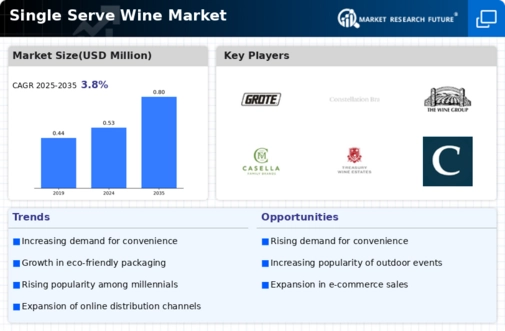Market Analysis
In-depth Analysis of Single Serve Wine Market Industry Landscape
Changing customer preferences and a dynamic beverage business have changed single-serve wine market dynamics. Single-serve wines in cans, bottles, or pouches are popular since they're portable. The changing consumer lifestyle, which demands on-the-go and quickly available solutions, drives market dynamics. For modern, fast-paced customers, single-serve wines provide a more flexible and convenient option to enjoy wine without opening a complete bottle.
Single-serve wines make it easy for wine lovers to try new flavors in a variety of locations, from hectic cityscapes to peaceful mountaintops. This ease drives single-serve wine sales. Its capacity to accommodate both interested novices and seasoned experts makes the market appealing, delivering a smooth and delightful wine-drinking experience regardless of location. Single-serve wine makes wine more accessible and inclusive for newcomers.
Single-serve wine also lets individuals and adventurers enjoy their favorite wines without packaging. The single-serve wine market's versatility widens its consumer base, whether on a mountain peak or a metropolitan skyline. The single-serve wine business thrives due to this versatility and the joy of discovering new wines in varied contexts.
The increase of outdoor and social events has impacted single-serve wine sales. Cans are ideal for picnics, concerts, and beach trips when glass bottles are impracticable. The mobility and ease of single-serve wine packaging make it perfect for social occasions or wine tasting without glassware.
Single-serve wine market dynamics depend on packaging innovation. Companies in this area develop eco-friendly and compact packaging solutions. Consumers appreciate ecologically friendly packaging, which affects buying decisions and market dynamics. Resealable lids and portable forms improve the customer experience and make single-serve wines more appealing.
Established wine producers and newcomers compete for market share, adding to market dynamics. Companies differentiate single-serve wines by brand awareness, quality, price, and marketing. Creative branding and attractive packaging boost product competitiveness. In this dynamic climate, people choose recognized brands that offer quality and flavor, thus brand loyalty is crucial.
Single-serve wine markets are similarly affected by wine consumption beliefs. Wine is linked with formal occasions and full-bottle drinking. Individual-serve wine alternatives have destigmatized casual wine consumption, making it more accessible and appealing. This perceived shift opens new markets and increases single-serve wine consumption.











Leave a Comment